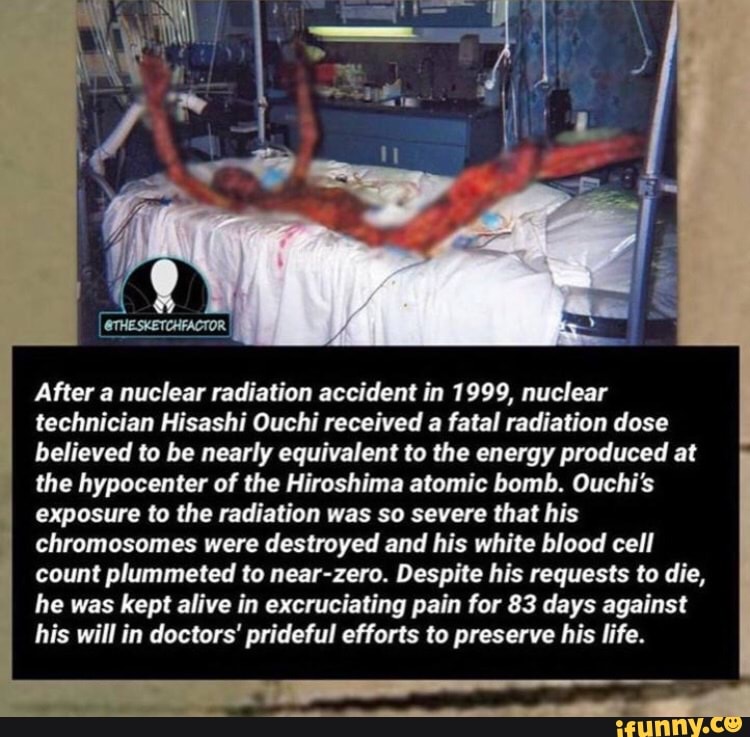Hisashi Ouchi, a name that resonates with resilience and tragedy, is a poignant reminder of the devastating consequences of nuclear radiation exposure. In 1999, Ouchi was one of the victims of the Tokaimura nuclear accident in Japan, where a criticality accident resulted in severe radiation exposure. His story is not just about survival; it’s about the human spirit’s incredible will to endure against all odds. Ouchi's harrowing experience sheds light on the long-term effects of radiation on the human body and the profound impact it has on both the individual and their loved ones.
As we delve into Hisashi Ouchi's life after radiation exposure, we uncover a complex narrative filled with challenges, medical interventions, and the quest for normalcy in a life forever altered. The aftermath of the accident left Ouchi fighting for his life, undergoing extensive medical treatment, and facing the psychological ramifications of his experiences. His journey is one that not only highlights the physical toll radiation can take but also emphasizes the need for better safety protocols in the nuclear industry to prevent such tragedies in the future.
In this article, we will explore the details of Ouchi's biography, the effects of radiation on his health, and the broader implications of his story. We will answer crucial questions surrounding his life after the accident, including what medical advancements were made in the wake of his suffering and how his story has influenced nuclear safety regulations. Join us as we navigate the life of Hisashi Ouchi, a survivor whose tale continues to resonate with countless individuals advocating for safety and awareness in the nuclear sector.
Read also:The Intriguing Life And Legacy Of James Polk Shaping A Nation
Who is Hisashi Ouchi?
Hisashi Ouchi was born on March 8, 1962, in the city of Tokyo, Japan. He was a dedicated nuclear technician who worked at the Tokaimura uranium processing facility. Ouchi's life took a catastrophic turn during a criticality accident on September 30, 1999, which led to his exposure to lethal levels of radiation. This incident not only changed the course of his life but also sparked debates about nuclear safety and the ethical considerations surrounding radiation exposure in the workplace.
| Personal Details | Bio Data |
|---|---|
| Name | Hisashi Ouchi |
| Date of Birth | March 8, 1962 |
| Place of Birth | Tokyo, Japan |
| Occupation | Nuclear Technician |
| Accident Date | September 30, 1999 |
| Radiation Exposure Level | Approximately 17 Sieverts |
| Status | Deceased (2000) |
What Happened During the Tokaimura Nuclear Accident?
The Tokaimura nuclear accident was a catastrophic event that occurred due to a series of human errors, inadequate safety protocols, and a lack of proper training. Ouchi, along with two other workers, was involved in the preparation of a mixture of uranium for a nuclear reactor. The workers unknowingly added too much uranium to the solution, leading to a criticality incident that resulted in an uncontrolled nuclear fission reaction.
As a result of the accident, Ouchi and his colleagues were exposed to extreme levels of radiation, which caused immediate and severe health complications. The radiation exposure led to acute radiation syndrome (ARS), which manifests in symptoms such as nausea, vomiting, hair loss, and damage to internal organs. Ouchi suffered extensively, and his medical journey became a focal point for discussions regarding radiation treatment and recovery.
How Did Hisashi Ouchi's Health Deteriorate After Radiation Exposure?
After the accident, Hisashi Ouchi was rushed to the hospital, where he underwent aggressive medical treatment to combat the effects of radiation. Despite the efforts of medical professionals, the damage inflicted by the radiation was profound. Ouchi experienced a rapid decline in health, characterized by severe symptoms of ARS, including:
- Severe skin burns
- Internal bleeding
- Immune system failure
- Organ damage
Hisashi Ouchi's condition was so critical that doctors struggled to provide adequate care. He became a multi-organ failure patient, requiring numerous transfusions and advanced medical interventions. His case became a subject of study for medical professionals to understand better the effects of high-dose radiation on the human body.
What Medical Treatments Did Ouchi Undergo?
Throughout his harrowing ordeal, Hisashi Ouchi underwent a multitude of medical treatments aimed at managing the effects of radiation. The following treatments were employed:
Read also:1. **Bone Marrow Transplant:** Due to the damage to his bone marrow caused by radiation, Ouchi was a candidate for a bone marrow transplant, which aimed to restore his blood cell production. 2. **Supportive Care:** Ouchi received extensive supportive care, which included hydration, pain management, and treatment for infections. 3. **Experimental Treatments:** Given the rarity of his condition, Ouchi was subjected to experimental treatments, including the use of growth factors to stimulate blood cell production. 4. **Psychological Support:** The psychological toll of his condition led to the necessity for mental health support, as Ouchi faced trauma from the accident and his ongoing health struggles.Expert Guide On Spirit Airlines Reviews An Indepth Analysis
Despite the state-of-the-art medical interventions, Ouchi's health continued to decline, leading to his eventual passing on December 21, 2000. His struggle sparked a global conversation about the safety and ethics surrounding nuclear energy and radiation exposure.
What Legacy Did Hisashi Ouchi Leave Behind?
Hisashi Ouchi's story is not just one of personal tragedy; it serves as a critical lesson for the nuclear industry and regulatory bodies worldwide. His experience highlighted the urgent need for:
- **Improved Safety Protocols:** There is an ongoing demand for stricter safety measures and regulations in nuclear facilities to prevent similar accidents from occurring in the future. - **Increased Training:** Workers in nuclear facilities must receive thorough training to handle radioactive materials safely and effectively. - **Public Awareness:** Ouchi's story has contributed to a broader public discourse on the risks associated with nuclear power and the importance of transparency in the industry.Hisashi Ouchi's legacy is one of advocacy for safety and awareness in nuclear energy, and his story continues to inspire changes in policies and regulations aimed at protecting workers and communities from the dangers of radiation exposure.
How Has Hisashi Ouchi's Case Influenced Nuclear Safety Regulations?
The tragic events surrounding Hisashi Ouchi and the Tokaimura nuclear accident led to significant changes in nuclear safety regulations both in Japan and globally. Key influences include:
1. **Revised Safety Standards:** Regulatory bodies reviewed and revised safety standards for nuclear facilities to minimize the risk of accidents. 2. **Emergency Response Training:** Enhanced training protocols for emergency response teams to effectively address potential radiation exposure incidents. 3. **Monitoring Systems:** Implementation of advanced monitoring systems to detect radiation levels and maintain safety within nuclear facilities.These changes have played a crucial role in improving safety measures and protocols within the nuclear industry, reducing the likelihood of similar incidents occurring in the future.
What Can We Learn from Hisashi Ouchi's Experience?
Hisashi Ouchi's experience serves as a powerful reminder of the importance of safety in the nuclear industry. It underscores the need for a proactive approach to radiation safety, including:
- **Continuous Training:** Ongoing training for workers to ensure they are equipped to handle radioactive materials safely. - **Regulatory Oversight:** Strong regulatory oversight to ensure compliance with safety protocols and standards. - **Community Engagement:** Engaging with communities to raise awareness about nuclear safety and the potential risks associated with radiation exposure.Ultimately, Hisashi Ouchi's story is one of resilience and tragedy, a cautionary tale that continues to resonate with individuals advocating for safety and awareness in the nuclear sector. His legacy lives on through the changes made in nuclear safety regulations and the ongoing dialogue surrounding the responsible use of nuclear energy.
In conclusion, the life of Hisashi Ouchi after radiation exposure is a heartbreaking yet inspiring account of human endurance in the face of adversity. His journey reflects not only the physical and emotional toll of radiation exposure but also the critical importance of safety and regulation in the nuclear industry. As we remember his story, let us strive to honor his legacy by advocating for a safer, more responsible future in nuclear energy.


